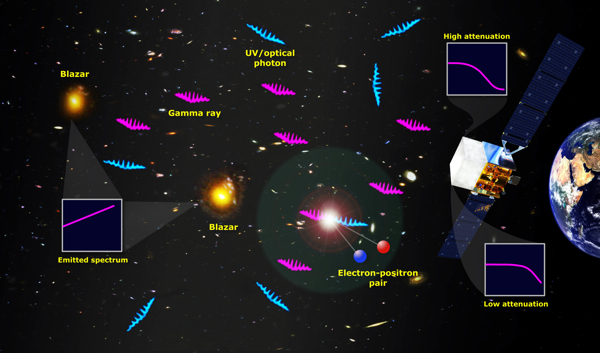Probing the Extragalactic Background Light
The Extragalactic Background Light (EBL), extending from the infrared through the optical and into the ultraviolet, is the total light from all of the stars (and to a lesser extent, active galactic nuclei) that have ever existed in the observable universe. Knowledge of the EBL is important for understanding the evolution of our Universe and the formation of stars and galaxies. Bright foreground sources from the Milky Way and solar system make direct measurements of the EBL challenging.
However, gamma-ray astronomy provides a powerful tool for measuring the EBL; gamma rays emitted by distant active galactic nuclei (AGN) may interact with EBL photons, creating electron-positron pairs, effectively absorbing the gamma rays. The EBL leaves a distinct imprint in the gamma-ray spectra of cosmic sources, an attenuation that increases with the distance of the source from us.

EBL Science with the LAT
The Large Area Telescope (LAT) on board Fermi measured the amount of gamma-ray absorption in blazar spectra produced by ultraviolet and visible starlight at three different epochs in the history of the Universe. The measurement (see below) shows clearly that the amount of absorption is higher at larger distances, for gamma rays emitted when the universe was younger. This is mostly due to the increase in the star formation activity of the Universe. + Learn More

The Gamma-ray Horizon
The EBL suppresses most of the flux of distant gamma-ray sources. The cosmic gamma-ray horizon refers to that distance at which only ~30% of the source flux arrives at the earth.
The detection of the highest energy photons (below) from distant sources allows Fermi-LAT scientists to probe the horizon from very low to very high redshift. This has important consequences for cosmology. + Learn More



